WindPower
Latest
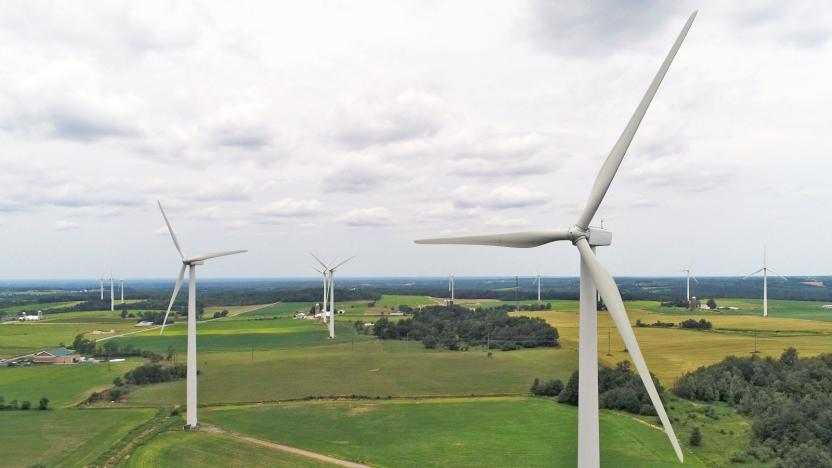
Google’s DeepMind can predict wind patterns a day in advance
Wind power has become increasingly popular, but its success is limited by the fact that wind comes and goes as it pleases, making it hard for power grids to count on the renewable energy and less likely to fully embrace it. While we can't control the wind, Google has an idea for the next best thing: using machine learning to predict it.
Christine Fisher02.26.2019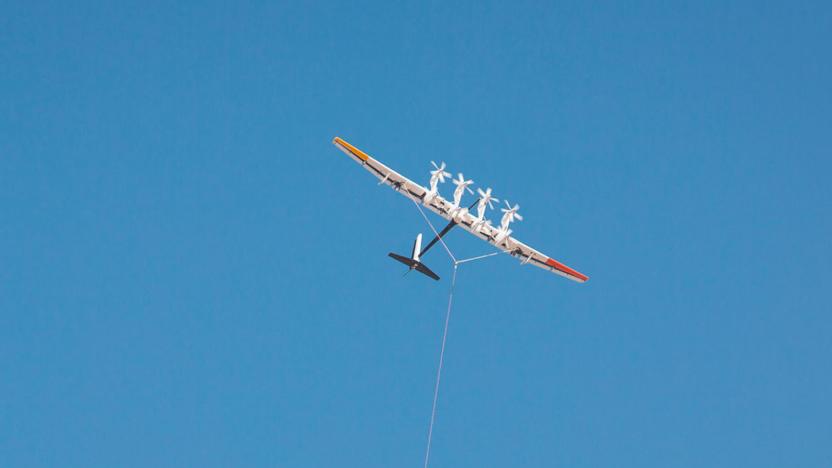
Shell backs Alphabet's power-generating kites in latest renewable bet
Alphabet is turning yet another one of its X projects into a business, but this time it's enlisting the help of an unusual ally. Makani Power, a venture making electricity-generating kites (see above), has become a full-fledged subsidiary of Alphabet thanks in part to a minority investment from Shell -- yes, the fossil fuel giant. The two hope to shift the technology from the land to offshore, where winds are stronger. They're betting that the kites will be easier to deploy than conventional wind farms, since they could deploy with floating buoys instead of requiring platforms that reach down to the ocean bed.
Jon Fingas02.12.2019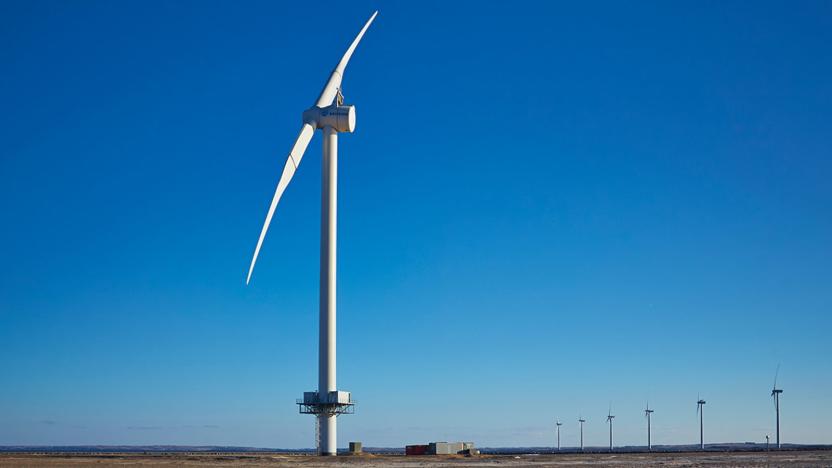
Superconducting tape could lead to lower-cost wind power
Wind power is limited in part by how expensive it can be to make each turbine. You may need roughly a ton of rare earth metals per machine... and that adds up. It could soon be much less expensive, however. The EU-backed EcoSwing project recently upgraded a wind turbine in Denmark with superconducting tape that reduces the required amount of rare earth elements to as little as 1kg (2.2lbs). That not only dramatically reduces the costs (down from $45.50/kg to $18.70/kg), it reduces weight and size requirements. You can produce the same power for about half the weight and volume of a conventional turbine, the University of Twente's Marc Dhalle told Chemistry World.
Jon Fingas11.24.2018
After Math: Ch-Ch-Ch-Changes
This has been quite the "disruptive" week with TechCrunch's marquee event going on at the San Francisco Moscone Center, and not just for startups. InfoWars was disinvited from yet another social media platform, Walmart is drastically expanding its self-driving Tesla truck order, and the world's largest wind farm just opened for business.
Andrew Tarantola09.09.2018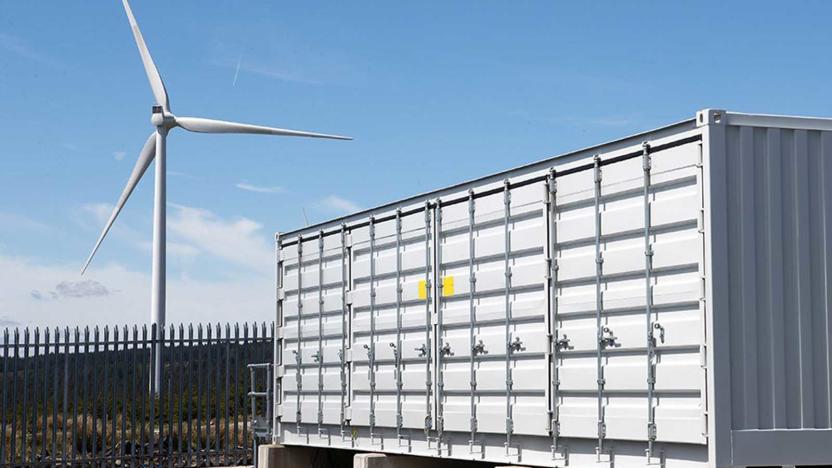
BMW i3 batteries provide energy storage for UK wind farm
The UK is now home to one of the largest energy storage projects using EV batteries. Vattenfall has connected a total of 500 BMW i3 batteries to the Pen y Cymoedd onshore wind farm in Wales, creating the biggest co-located installation in the UK. The add-on (housed in six containers like the one above) will help provide a more reliable source of renewable energy -- it'll provide consistent, readily available power.
Jon Fingas05.21.2018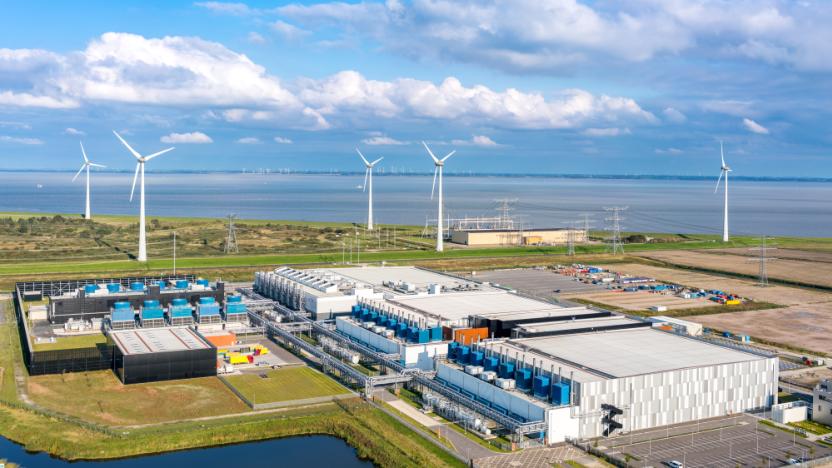
Google uses wind and solar to offset all of its operational energy use
In late 2016, Google announced that it expected to offset all of its office and data center electricity use with 100 percent renewable energy in 2017. Today, the company says it achieved that goal. Google has been working on reducing its carbon footprint and purchasing more renewable energy for some time. In 2007, it committed to being carbon neutral, which it did by purchasing solar and wind energy as well as carbon offsets, and throughout the years, it has reduced its reliance on offsets and purchased greater amounts of renewable energy. In 2017, for every kilowatt-hour of energy Google's operations consumed, it added a kilowatt-hour of solar and wind energy to the grid.
Mallory Locklear04.04.2018
Renault's 'smart island' runs on wind power and recycled batteries
Renault has launched a "smart island" in Portugal that uses its Zoe electric vehicle, home batteries, smart charging and vehicle-to-grid (V2E) energy storage to run without fossil fuels. The idea is to make the Madeira island of Porto Santo energy independent and stimulate renewable energy production. "[We want] to build a model that can be carried over to other islands and cities," Renault Electric Vehicle Director Eric Feunteun told Engadget.
Steve Dent02.21.2018
Tesla's latest smart power grid experiment begins in Canada
Tesla's experiments with smart power grids are headed further North. Canada's Nova Scotia Power recently finished setting up a pilot project that will use a combination of Tesla's Powerwall 2 home batteries and utility-grade Powerpack batteries to create a more reliable wind power system. The Elmsdale-based Intelligent Feeder Project fills gaps in the electrical grid by topping up the Powerpacks whenever a nearby wind turbine system generates excess power, and delivering that stored energy to local homes (including those with Powerwall 2 batteries) when there's an outage or the turbine system falls short.
Jon Fingas02.18.2018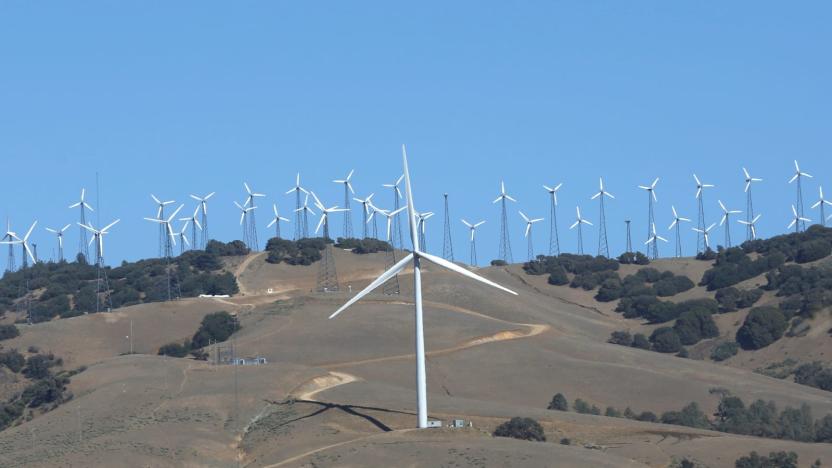
Nearly all new US electricity capacity was renewable in 2017
Renewable energy played an important role in the US last year... although you might not want to cheer too loudly. Data from both the Rhodium Group and the Energy Information Administration shows that solar and wind power represented 94.7 percent of the net new electricity capacity (15.8GW out of 16.7GW) added in 2017. However, that's mainly because fossil fuel power continued to fade away. Electrek noted that plant closures removed 11.8GW of utility-scale fossil fuel power from the equation -- this was more a testament to the decline of coal than a triumph for green tech.
Jon Fingas01.15.2018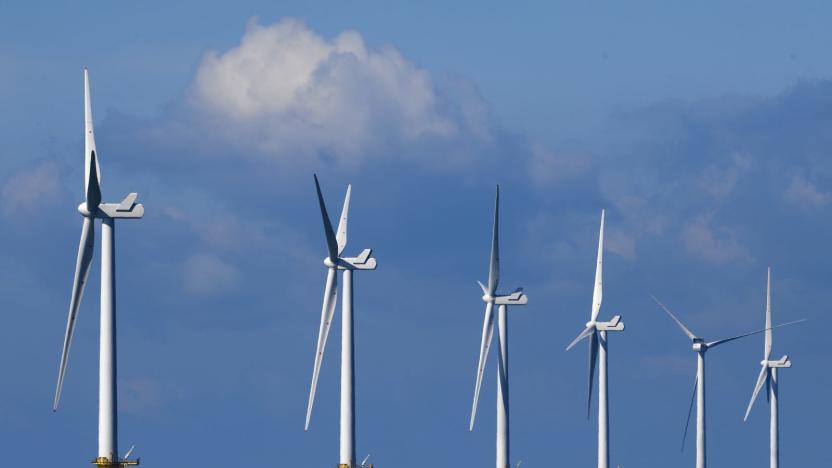
Renewable energy outstripped coal use in the UK for most of 2017
The UK has been working to significantly reduce its carbon emissions and with that effort, it hit some major green milestones this year. In April, the country went a full day without coal-generated power for the first time in 135 years. And in June, the country saw more than half of its energy being generated by renewables (i.e. solar, wind, hydropower and biomass) for the first time.
Mallory Locklear12.28.2017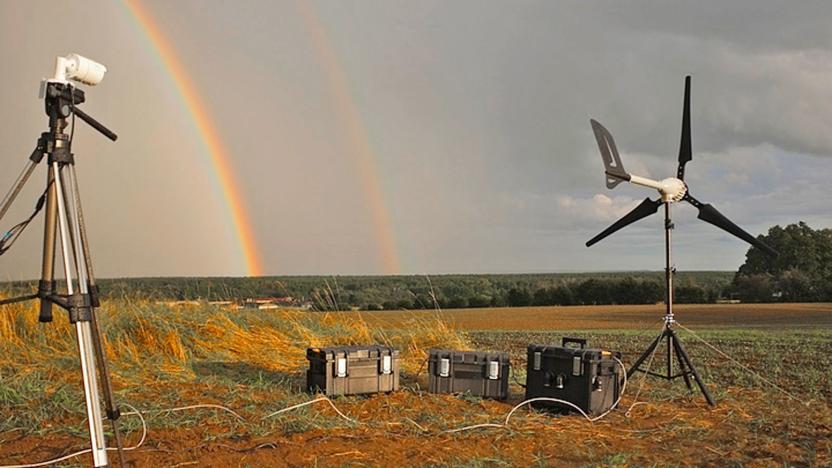
Wind energy mines digital cash to support climate research
Climate change is frequently described as a vicious cycle that depletes the very resources needed to fight it. In the case of Julian Oliver's latest project, however, it could almost be described as virtuous. His Harvest project uses a 700W wind turbine to power a PC mining cryptocurrency (specifically, Zcash) that directly funds climate change research. In other words: the more the symptoms of climate change manifest themselves, the more money goes toward fighting that change. It was commissioned as a piece of art, but it's a very practical design that could find plenty of uses in the real world.
Jon Fingas09.16.2017
All electric trains in the Netherlands now run on wind energy
The Netherlands has been harnessing the power of the wind to drain bodies of water, saw timber and to produce oil for centuries. Now, the country is also using it to run all its electric trains. The Dutch railways network (NS) started using wind energy generated by the turbines owned by electric company Eneco two years ago when they signed a ten-year agreement. They planned to power all of the country's electric trains with wind-generated energy by 2018, but they're clearly a shining example of Dutch efficiency and reached their goal a year earlier than planned.
Mariella Moon01.12.2017
Six places where renewable energy is cheaper than fossil fuels
By Cat DiStasio In the race to reduce the world's reliance on fossil fuels, cost is a huge factor. It's taken years, but advances in technology and increases in both efficiency and output have helped bring down the expense of renewable energy, which has in turn increased demand. Globally, fossil fuels are still cheaper than these alternative sources, but there are a few places around the world where clean energy is winning, dollar for dollar. Sometimes, too, there's so much of it that the market price drops to zero. With the cost of renewable energy getting lower by the year, if not the month, environmental advocates are hopeful that energy sources like solar and wind power can eventually edge out fossil fuels entirely. Let's take a look at some of the locales where renewable energy is proving that a clean world doesn't have to be more expensive.
Inhabitat12.10.2016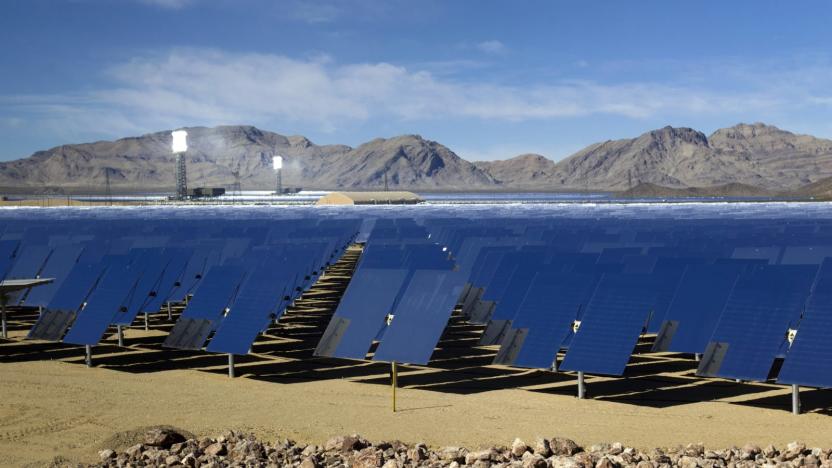
Google expects to run solely on renewable energy in 2017
Google has made it a point to run as much of its business on renewable energy as possible, and it looks like the company is close to reaching its ultimate goal. The internet pioneer now expects that all of its offices and data centers will be relying on purchased solar or wind power by some point in 2017. This isn't the same as directly powering facilities with eco-friendly energy (logistics and the nature of electrical grids makes that difficult), but it does mean that Google is funding enough projects to offset its massive power demands -- 5.7 terawatt-hours in 2015.
Jon Fingas12.06.2016
ICYMI: Sea power could take wind power's bragging rights
try{document.getElementById("aol-cms-player-1").style.display="none";}catch(e){}Today on In Case You Missed It: Nova Innovation is installing the world's first tidal power generators along the coast of Scotland, which are able to produce 100 kilowatts of power each. The UK Carbon Trust estimates the tidal energy market will be worth $165 Billion by 2050. The P-Laser that strips rust in an instant is here, and if you're as into amazing dogs as we are, you must see the nicknozzy YouTube channel. As always, please share any interesting tech or science videos you find by using the #ICYMI hashtag on Twitter for @mskerryd.
Kerry Davis08.31.2016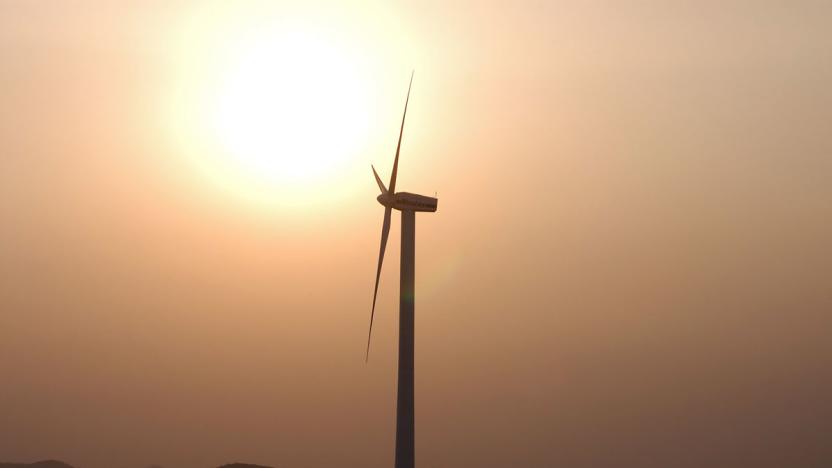
Google invests in Africa's largest wind power farm
Google's big bet on clean energy isn't just limited to the US or Europe -- far from it. The search firm just promised to invest in Africa's largest wind farm, the Lake Turkana Wind Power Project in Kenya, by buying turbine maker Vestas' 12.5 percent stake when the farm is complete. Lake Turkana should generate 310MW of energy when all is said and done, or as much as 15 percent of Kenya's current output. That could not only help the country transition to green energy sources, but give it the kind of reliable electricity that's tough to find in the region.
Jon Fingas10.20.2015
Clean energy is nearly as inexpensive as coal and gas
One of the biggest obstacles to adopting solar or wind power is simply the cost of getting started. However much an electricity company might save in the long run, that up-front expense is tough to swallow. Or rather, it was -- Bloomberg New Energy Finance study has found that the cost of clean energy has dropped so much that it's within spitting distance of dirty sources like coal and gas. The global average cost of onshore wind power has dipped to $83 per megawatt-hour, while silicon solar power now costs $122. Neither of those figures is trivial, but they're not much different than what firms pay for coal (which has risen to $75 per MWh in the Americas) or gas turbines ($82 per MWh). Some green tech is still expensive, such as offshore wind ($174) and marine ($400-plus), but prices have fallen there, too.
Jon Fingas10.06.2015
GE's big-nosed wind turbine generates more power
Despite their giant blades, most wind turbines waste a lot of energy -- gusts around the rotor don't really generate electricity at all. GE thinks it can do better, however. Its experimental ecoROTR turbine touts a big, rotating aluminum nose that sends wind directly toward the blades, where it's more effective. The current design boosts the power output by a modest 3 percent, but that could matter a lot in a large wind farm. The big deal may be what comes next. EcoROTR allows for bigger rotors without having to use larger, harder-to-transport blades. If it ventures beyond the prototype stage, you could see more wind farms in remote locations that both produce more power and keep giant, noisy towers away from your neighborhood.
Jon Fingas06.07.2015
Americans are using more energy, but green tech is softening the blow
It may be tough to satisfy the US' seemingly never-ending thirst for energy, but clean power sources are at least helping to soften the impact. Researchers at the Lawrence Livermore National Laboratory have determined that Americans' energy use climbed 1 percent year-over-year in 2014, but its carbon emissions hardly budged at all. In fact, they were down significantly for coal and petroleum-based power. While some of that decline is due to industry using less-than-clean natural gas, it's also helped by big jumps in solar and wind energy, which respectively grew by 33 and 8 percent.
Jon Fingas05.21.2015
New York City's first commercial wind turbine proves its worth
Sunset Park in Brooklyn is home to New York City's first commercial-scale wind turbine, and it's already flexing its green muscle. In under a month, the 160-foot-tall power source produced enough juice to power two homes for more than 12 months. It's not being used to supplement regular energy use, though, as it feeds a recycling plant at the South Brooklyn Marine Terminal -- a facility that already gets 16 percent of its power from solar panels. NYC seems like the last place a massive wind turbine would make a difference, but the height of this installation, coupled with the open landscape on the shore of Sunset Park, makes for an effective combo that's capable of generating up to 100 kilowatts. Attempts to harvest the wind in New York City are nothing new, but they're typically used to power much smaller buildings, so their size and output are a fraction of this one at Sims Metal Management. Construction costs tallied $750,000, and the project is expected to pay for itself in five years. [Photo credit: AP Photo/Bebeto Matthews]
Billy Steele01.16.2015